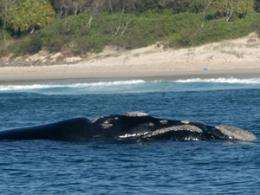As record numbers of whales pass New South Wales during the annual northern migration, scientists and conservationists are watching for southern right whales particularly carefully, following new research released this month.
The research, published in Marine Ecology Progress Series, tells an exciting story of recovery and recolonisation amongst the southern rights in New Zealand and Australia but is also coupled with a reminder of our local responsibilities.
The southern right was named for its historic reputation as the ‘right' or best whale to hunt during the 19th century. This intensive interest brought the southern right to the brink of extinction and then to become the first whale identified for protection as an endangered species.
Professor of Marine Ecology at Macquarie University, Rob Harcourt, describes how the whales are now showing signs of long-term recovery.
"Only a small number of southern right whales managed to survive the intense whaling, within populations known as ‘isolated remnants', breeding within sub-Antarctic waters south of Australia and New Zealand.
"Now, this new research suggests that growing numbers of a distinct remnant group are returning to the mainland coast of New Zealand, to give birth and raise their calves - an exciting development in recolonisation", he says.
Scientists from the University of Auckland, NZ Department of Conservation, Australian Antarctic Division, Macquarie University, the Museum of Western Australia and Oregon State University have summarised the results of analyses of genetic sample collected across nearly two decades of study.
However, the same study also uses genetic evidence to show that the southern rights off the east coast of Australia (such as those appearing off Eden and occasionally venturing into Sydney Harbour) are distinct from populations recolonising New Zealand and recovering in Western Australia.
The finding means that we have a particularly high responsibility to our local population, says Harcourt, as it is a small, distinct and therefore especially vulnerable remnant. "We see these southern rights coming into Sydney Harbour, Warrnambool and the Derwent on occasion but it's too early to say whether recovery is happening here on the same scale," he explains.
Harcourt describes the southern right as unique, and one of the largest whales in the ocean.
"When watching for whales, you can distinguish a southern right by the callosities, or barnacles, on its head. They can weigh up to 80 tonnes - almost 4 double-decker buses - and just under the world's largest, the Blue Whale, at 120 tonnes".
Provided by Macquarie University






















